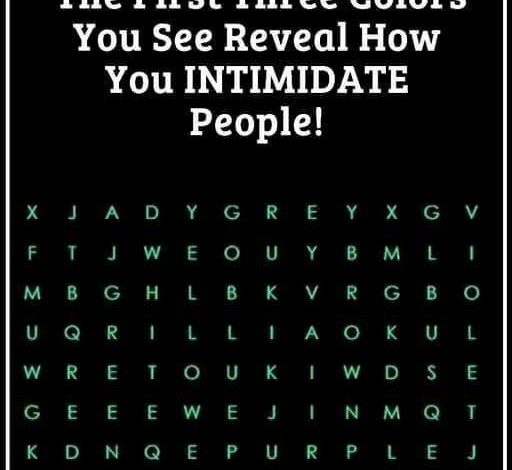How Colors Influence Perception: The Psychological Power of Color Word Puzzles

ADVERTISEMENT
How Colors Influence Perception: The Psychological Power of Color Word Puzzles
Color has a profound impact on human psychology, influencing our emotions, perceptions, and even behaviors. In recent years, playful word puzzles that claim to reveal aspects of one’s personality based on the colors you first notice have gained popularity on social media. The image you’ve shared is one such puzzle, inviting participants to identify the first three colors they see in a grid of letters, with the promise that these choices reveal how they “intimidate” others.
The Allure of Personality Puzzles
Personality quizzes and puzzles have long been a popular form of entertainment, offering insights—whether scientifically based or purely for fun—into our traits, behaviors, and how we are perceived by others. The idea that the colors we notice first in a puzzle could reveal something about our personality, particularly how we may intimidate others, taps into our curiosity about self-identity and interpersonal dynamics.
But why are these puzzles so captivating? The answer lies in a combination of psychology and human nature:
- Self-Reflection: People are naturally interested in learning more about themselves. Personality quizzes provide a mirror, however imperfect, that allows us to explore and reflect on our own characteristics.
- Social Interaction: These puzzles often encourage sharing results with friends or on social media, sparking conversations and comparisons that can be both entertaining and revealing.
- Mystery and Fun: The element of surprise in discovering new aspects of ourselves—or simply the enjoyment of solving a puzzle—adds to the appeal.
The Psychology of Color
While the specific claims of puzzles like the one you’ve shared may be more for fun than scientific analysis, there is a substantial body of research on the psychology of color. Different colors can evoke different emotions and associations, and these effects can vary depending on cultural context and personal experiences.
Here’s a brief overview of what some common colors often signify in psychological terms:
ADVERTISEMENT
- Red: Often associated with passion, energy, and action. It can also represent danger or aggression, making it a color that can be perceived as intimidating in certain contexts.
- Blue: Generally linked to calmness, trust, and stability. However, in darker shades, blue can also evoke feelings of seriousness and authority, which might be intimidating to some.
- Yellow: A bright, cheerful color associated with happiness and optimism. However, it can also be overwhelming or anxiety-inducing in large amounts.
- Green: Represents nature, growth, and harmony. While green is often calming, certain shades, particularly darker ones, can convey ambition and power.
- Purple: Often associated with luxury, mystery, and spirituality. Purple can be perceived as both creative and authoritative, making it a color that commands respect.
- Grey: Represents neutrality, balance, and sophistication. While grey is often seen as calm and composed, it can also come across as distant or unapproachable.
- Black: A color of sophistication, power, and elegance. Black can be very intimidating, symbolizing control, formality, and even mystery.
- White: Represents purity, simplicity, and cleanliness. White is generally seen as non-threatening, though it can also be perceived as cold or impersonal.
Interpreting the Puzzle
The puzzle in the image suggests that the first three colors you see will reveal how you intimidate others. While this is a fun and light-hearted activity, it can also prompt interesting reflections on how we present ourselves and how others might perceive us based on these color associations.
For example, if someone first notices the color red, they might be seen as someone who is energetic and possibly a bit intense, which could be intimidating in situations that require calm or subtlety. Conversely, if the first color is blue, they might be perceived as someone who intimidates through calm authority rather than overt action.
The Social Dimension
Sharing the results of such puzzles with others can lead to fascinating discussions about personality and perception. Do your friends or colleagues agree with the colors you saw first and what they represent? How do they perceive you in terms of the traits associated with those colors? These conversations can deepen relationships and help us understand how we are viewed in different social contexts.
Conclusion: The Fun in Self-Discovery
While puzzles like the one you’ve shared are primarily meant for entertainment, they do tap into deeper aspects of psychology and self-perception. The colors we are drawn to and the meanings we ascribe to them can offer insights, however subtle, into our personalities and how we relate to the world around us.
At the end of the day, these puzzles are a fun way to engage with friends, explore aspects of your personality, and maybe even learn something new about yourself. So, whether the colors you saw first truly reveal how you intimidate others or just provide a fun diversion, they remind us of the power of color and perception in our daily lives.
ADVERTISEMENT
This article provides a detailed exploration of the psychology of color and the appeal of personality puzzles, offering insights into how such simple activities can tap into deeper aspects of self-perception and social interaction.




